OCEAN MATERIAL | JUN 16TH 2025 | 15 MIN
Ocean-Bound Plastic – More Than a Buzzword
Table of Contents
- What Most People Get Wrong About Ocean Plastic
- What Is Ocean-Bound Plastic – Really?
- Why Ocean-Bound Plastic Needs Real Solutions
- How Ocean Material® Gets Done – Step by Step
- The People Behind the Ocean-Bound Plastic
- From Waste to Value
- Our Holistic Approach to Ending Ocean Plastic
- Ready to Build With Certified Ocean-Bound Plastic?
What Most People Get Wrong About Ocean Plastic
Most plastic in our oceans doesn’t come from illegal dumping at sea. It starts on land – in broken waste systems, rivers, and coastlines without infrastructure. Once plastic is exposed to sun, saltwater, and time, it degrades into brittle fragments and becomes nearly impossible to recycle.
That’s why prevention matters more than cleanup. And why Ocean Material® operates directly in high-risk coastal regions to stop plastic before it enters the ocean.
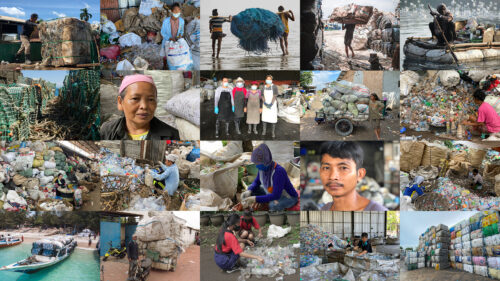
Image: The Real Faces of Ocean Plastic
Caption: A glimpse into the diverse realities of plastic waste in Southeast Asia – from waste pickers and ghost nets to certified recycling hubs. Each face and scene represents a step in Ocean Material®’s traceable supply chain.
What Is Ocean-Bound Plastic – Really?
The term “ocean-bound plastic” (OBP) was defined by Dr. Jenna Jambeck in 2015 as mismanaged plastic waste within 50 km of the coastline. Since then, the term has evolved to include:
- Potential OBP – poorly managed waste near coasts
- Waterway OBP – material in rivers and canals
- Shoreline OBP – debris close to beaches
- Fishing gear OBP – discarded nets, lines, and traps
At Ocean Material®, a main part of our work is recovering fishing nets from small coastal communities. These nets were historically disposed of directly at sea and are now returned through structured collection systems. While technically part of the ‘ocean-bound plastic’ category, we treat and communicate this material as ‘ocean plastic’ – due to its direct marine exposure, high ecological impact, complex processing requirements, and because it represents the most harmful form of marine plastic pollution.
Why Ocean-Bound Plastic Needs Real Solutions
Without working systems, OBP is just another label. Here’s what doesn’t work:
- Buying untraceable plastic through middlemen
- Paying waste pickers unfairly
- Shipping low-value materials without local benefit

Image: Local collectors sorting plastic
Caption: Empowering waste collectors through fair pay and verified traceability
How Ocean Material® Gets Done – Step by Step
From Collection to Certified PET Flakes – The Full Process in 9 Steps
📍 All images below were taken at Ocean Material® partner sites in Southeast Asia – where our certified ocean-bound plastic supply chains begin.
Step 1: It starts here
How Ocean Material® gets done step by step
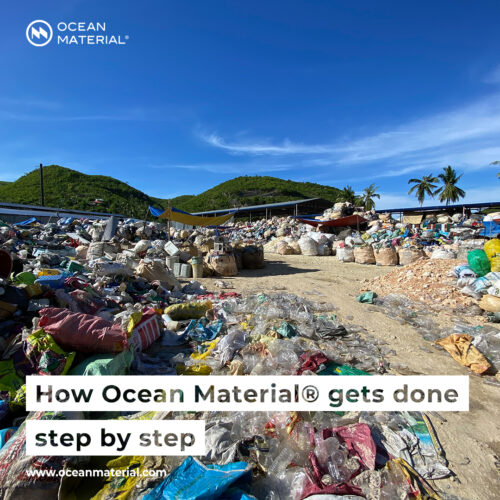
Remote coastal regions with inadequate waste infrastructure – here, plastic waste piles up without alternatives. We step in to create value from what would otherwise be lost.
Step 2: Collected by hand
Sorted by local collectors
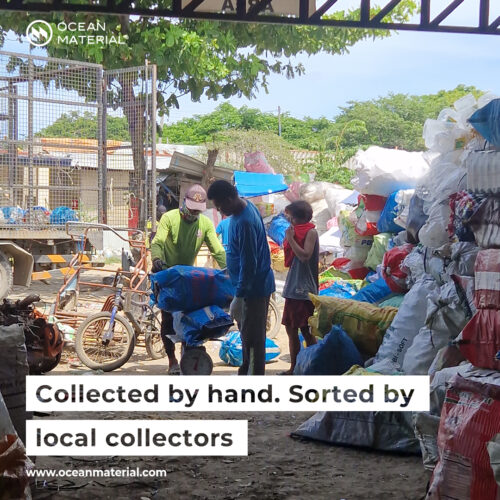
Waste pickers and micro-entrepreneurs collect mixed plastic, often using simple tools. Fair pay and dignity matter – every sack is weighed, documented, and traced.
Step 3: Separated by material type
Bottles are grouped by type – ready for the next step
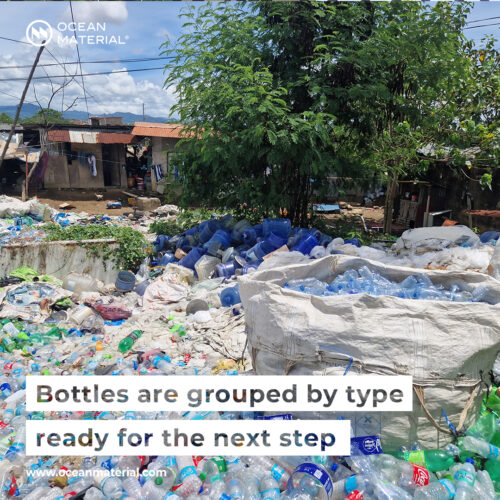
Sorting begins right after collection. PET bottles are separated from HDPE, PP, and other plastics to ensure clean input streams.
Step 4: Further separation
Colors separated and labels removed – mostly by hand
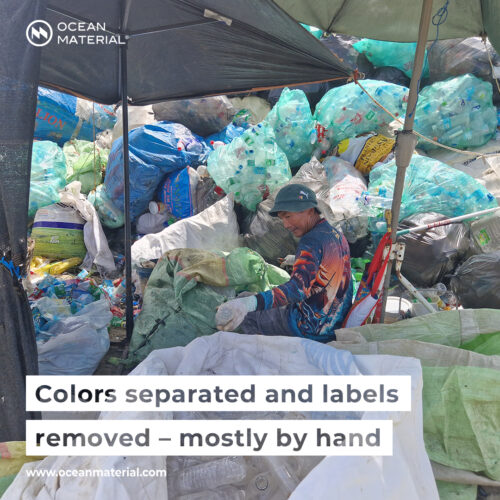
Manual sorting ensures quality: colored bottles are set aside, caps and labels removed, and contamination kept to a minimum.
Step 5: Pre-processing facility intake
Stored at pre-processing facility – ready for recycling

After sorting, materials are delivered to local partner facilities where pre-cleaning and storage prepare them for recycling.
Step 6: Pre-wash inspection
Pre-wash inspection before wet processing
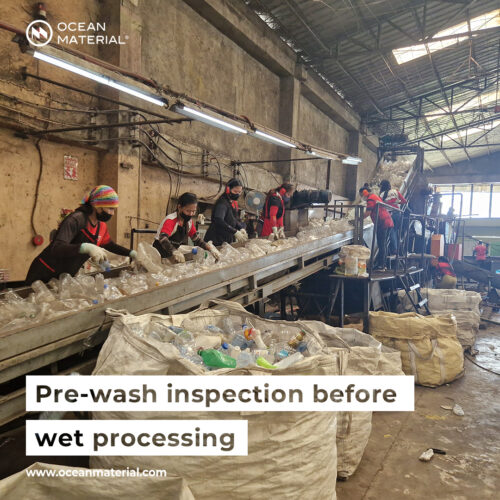
Bottles pass along inspection belts where trained staff remove remaining contaminants and perform visual checks.
Step 7: Cold wash
Cold washed – Dirt and dust out, value in
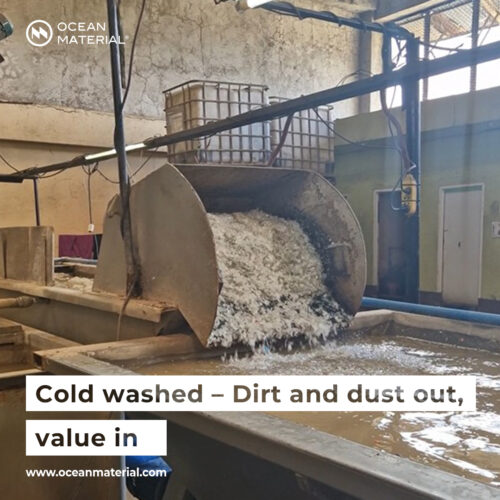
Low-energy washing removes surface dust and organic residue – critical for maintaining material integrity.
Step 8: Hot wash
Hot washed – For quality that meets global standards
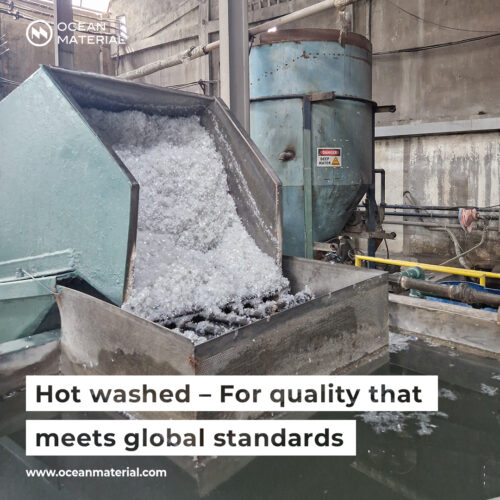
Intensive washing ensures hygiene and prepares the material for use in consumer goods, packaging, and textiles.
Step 9: Final output
Ocean Material® – PET flakes. Certified. Traceable. Circular.
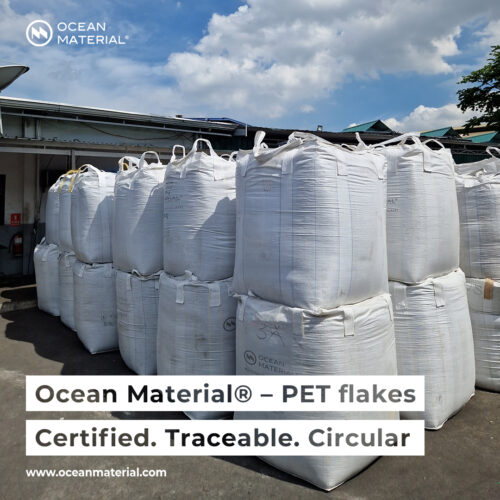
Our flakes are ready for upcycling – used by global brands in textiles, packaging, furniture, and logistics. Every batch is documented, traceable, and impact-proven.
The People Behind the Ocean-Bound Plastic
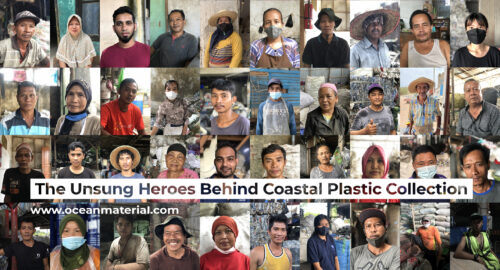
Image Collage: Portraits of workers, collectors, and community members
Caption: Real people. Real jobs. Real impact.
Our approach only works because it’s built around people. Community collectors, recyclers, fishers, processors – they are the true backbone of every flake we produce.
We don’t buy plastic anonymously. We know who collects it. We know how it was handled. And we document it every step of the way.
From Waste to Value
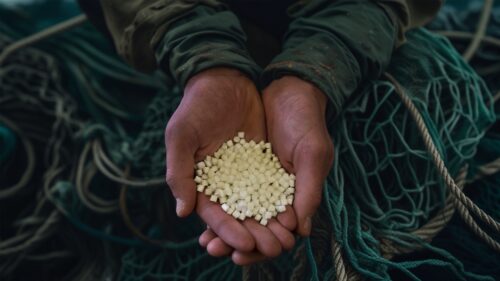
Image: Hands holding recycled pellets over fishing net
Caption: From ghost gear to high-quality recyclate.
Our technology turns formerly low-value plastic into high-performance materials used by global brands – from textiles to packaging to logistics.
Every product made from Ocean Material® helps:
- Prevent ocean plastic
- Create fair jobs
- Drive circularity
Our Holistic Approach to Ending Ocean Plastic
🧠 Education as Prevention
We believe true circularity starts before collection. That’s why we organize educational workshops in coastal communities to:
- Raise awareness about plastic waste and its environmental risks
- Offer insights into global supply chains and material value
- Help communities adopt better practices and prevent ocean leakage from the start
Ocean Material® is designed to intercept, upcycle, and replace harmful plastic flows before they reach the ocean.
⚓ Fishing Nets & Gear: The Critical Threat
Fishing gear accounts for up to one third of ocean plastic – and it’s the deadliest form. Ghost nets entangle marine animals, damage coral reefs, and are nearly impossible to remove once submerged. We:
- Recover and recycle nets, ropes, and cages from fishing communities
- Upcycle gear into high-performance materials
- Track and document recovery with full traceability
🌿 Seaweed-Based Packaging: A Natural Replacement
We’re developing biodegradable packaging from seaweed feedstocks, sourced responsibly from marine farming communities. It’s:
- Home-compostable
- Designed to replace single-use plastics in food, cosmetics, and dry goods
- Free from microplastic risks
♻️ Upcycling Complex Mixed Waste: Turning Trash into Assets
Low-value mixed plastic streams (like film, wrappers, multilayers, mixed textiles, PVC – typically non-recyclable) are a massive contributor to landfill and incineration. Our proprietary low-energy panel technology transforms this “unusable” plastic directly into:
- Construction-grade lightweight panels ideal for construction
- Modular logistics modules (e.g. pallets, protective boards)
Ready to Build With Certified Ocean-Bound Plastic?
No shortcuts. No greenwashing. Just certified material, local impact, and global quality.
Every batch is traceable. Every solution is built for impact.
Let’s build better materials – from the coast up.
🌍 Learn more about Ocean Material® and our global solutions at oceanmaterial.com.
Explore more:
16.06.2025
FAQ
Not at all. There’s a big difference between high-quality nets from commercial aquaculture – often used in inland freshwater farms and changed regularly – and fishing gear recovered from coastal communities or collected as ghost nets.
At Ocean Material®, we focus on nets with real marine impact: those used in open-water fishing, often discarded at sea or abandoned by small-scale fishers. These nets pose a serious environmental threat and are commonly classified as ocean plastic – not just ocean-bound plastic – due to their marine exposure, ecological harm, and complex recovery.
Because it’s deadly. Ghost nets kill marine life and damage ecosystems. Fishing gear represents one of the most harmful and persistent types of marine debris. That’s why we recover, trace, and upcycle nets, ropes, and cages – turning threat into value.
Unlike many in the market, we don’t act as middlemen. Ocean Material® can be purchased directly from certified recyclers – without trading layers or inflated margins. That means maximum efficiency, full traceability, and real transparency from source to shipment. We work directly with communities, avoid resellers, and certify every batch with OceanCycle.
For many short-use items like wrappers, coatings, or laminated paper – yes. Our current seaweed-based portfolio includes flexible films, coatings, and molded applications. All are marine-safe, home-compostable, and free from microplastic risks. More product types are in development.
